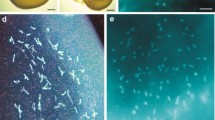Summary
The bisexual species Luffia lapidella has a pseudogamic (or gynogenetic) form, which is thelytokous and very similar to the parthenogenetic L. ferchaultella, but its egg needs the stimulation of the sperm.
The inseminated egg restores its diploid chromosomal number in performing the same kind of restitutional first meiotic division as ferchaultella does. The second division, although already diploid, is normal and is followed by the formation of two nuclei, one of them degenerating as a polar body. The sperm starts developing as in the normal egg, but by metaphase II, it stops growing to a pronucleus and remains as a contracted and pycnotic body. Although attracted by the central female nucleus, it does not fuse with it. The male centriole behaves normally, it possibly plays a role in the first cleavage mitosis. The egg divides diploid and without any paternal chromosomes.
Similar content being viewed by others
Bibliographie
Bělař, K.: Die Cytologie der Merospermie bei freilebenden Rhabditis-Arten. Z. Zellen- u. Gewebelehre 1, 1–21 (1924).
Benazzi, M.: Eredità materna nella Planaria Polycelis nigra. Atti Soc. Tosc. Sci. Nat. 55 B, 1–6 (1948). - La ginogenesi naturale (Pseudogamia). Problemi die Sviluppo. p. 38–64. Milano: Ambrosiana 1954. - Nuove acquisizioni nel dominio della pseudogamia. Monit. zool. ital. 69, 1–21 (1961).
—, e G. Benazzi-Lentati: Ulteriori osservazioni sulla ovogenesi e sul ciclo cromosomico del biotipo G di Dugesia benazzii della Sardegna. Arch. Zool. ital. 35, 251–263 (1950).
Brachet, A.: L'œuf et les facteurs de l'ontogénèse. In: Encycl. scient. Paris: Doin 1931.
Chapman, T. A.: Luffia maggiella, n. sp. Entom. Rec. 13, 80 (1901).
Hertwig, P.: Abweichende Form der Parthenogenese bei einer Mutation von Rhabditis pellio. Arch. mikr. Anat. 94, 303–337 (1920).
Krüger, E.: Fortpflanzung und Keimzellenbildung von Rhabditis aberrans, nov. sp. Z. Zool. 105, 87–124 (1913).
Lepori, N. G.: Ricerche sulla ovogenesi e sulla fecondazione nella Planaria Polycelis nigra Ehrenberg con particolare riguardo all'ufficio del nucleo spermatico. Caryologia (Firenze) 1, 280–295 (1949).
Lieder, U.: über die Eientwicklung bei männchenlosen Stämmen der Silberkarausche Carassius auratus gibelio Bloch (Vert. Pisces). Biol. Zbl. 78, 284–291 (1959).
Narbel-Hofstetter, M.: La pseudogamie chez Luffia lapidella Goeze (Lépid.Psych.). Rev. suisse Zool. 62, 224–229 (1955).
Narbel-Hofstetter, M.: La pseudogamie chez Luffia lapidella Goeze (Lépid.Psych.). Rev. suisse Zool. 62, 224–229 (1955).
—: La cytologie des Luffia: Le croisement de l'espèce parthénogénétique avec l'espèce bisexuée. Rev. suisse Zool. 63, 203–208 (1956).
—: Thélytoquie et pseudogamie chez Luffia (Lepid. Psych.). Arch. Klaus-Stift. Vererb.-Forsch. 32, 469–474 (1957).
—: Le sort des polocytes dans les œufs de Luffia (Lepid. Psych.) Arch. Klaus-Stift. Vererb.-Forsch. 33, 57–62 (1958).
—: La surmaturation des œufs de Luffia (Lepid.Psych.) Rev. suisse Zool. 67, 237–244 (1960).
—: Cytologie comparée de l'espèceparthénogénétique Luffia ferchaultella Steph. et de l'espèce bisexuée L. lapidella Goeze (Lepidoptera, Psychidae). Chromosoma (Berl.) 12, 505–552 (1961).
—: Lecroisement des espèces parthénogénétique et bisexuée chez Luffia (Lépidoptère Psychide). Les élevages et leurs résultats. Rev. suisse Zool. 69, 465–479 (1962).
Nigon, V.: Le déterminisme du sexe et la pseudogamie chez un Nématode parthéogénétique Rhabditis monohystera Bütschli. Bull. biol. France et Belg. 81, 33–37 (1947).
—, et Delavault, R.: L'évolution des acides nucléiques dans les cellules reproductives d'un Nématode pseudogame. Arch. Biol. (Liège) 63, 393–399 (1952).
—, et E. Roman: Le déterminisme du sexe et le développement cyclique de Strongyloides ratti. Bull. biol. France et Belg. 86, 404–448 (1952).
Rostand, J.: La parthénogénèse animale. Paris: Presses univ. de France 1950.
Seiler, J.: Geschlechtschromosomen-Untersuchungen an Psychiden. IV. Die Parthogenese der Psychiden. Z. indukt. Abstamm.- u. Vererb.-L. 31, 1–99 (1923). Untersuchungen über die Entstehung der Parthenogenese bei Solenobia triquetrella F. R. (Lepid. Psych.) I. Die Zytologie der bisexuellen S. triquetrella, ihr Verhalten und ihr Sexualverhältnis. Chromosoma (Berl.) 10, 73–114 (1959).
—: II. Analyse der diploid parthenogenetischen S. triquetrella. Verhalten, Aufzuchtresultate und Zytologie. Chromosoma (Berl.) 11, 29–102 (1960).
Tchou-Su: Etude cytologique sur l'hybridation chez les Anoures. Arch. Anat. micr. Morph. exp. 27, 1–105 (1931).
Author information
Authors and Affiliations
Additional information
Travail subventionné par le Fonds National Suisse de la Recherche Scientifique.
Rights and permissions
About this article
Cite this article
Narbel-Hofstetter, M. Cytologie de la Pseudogamie chez Luffia lapidella Goeze (Lepidoptera Psychidae). Chromosoma 13, 623–645 (1963). https://doi.org/10.1007/BF00325982
Received:
Issue Date:
DOI: https://doi.org/10.1007/BF00325982




